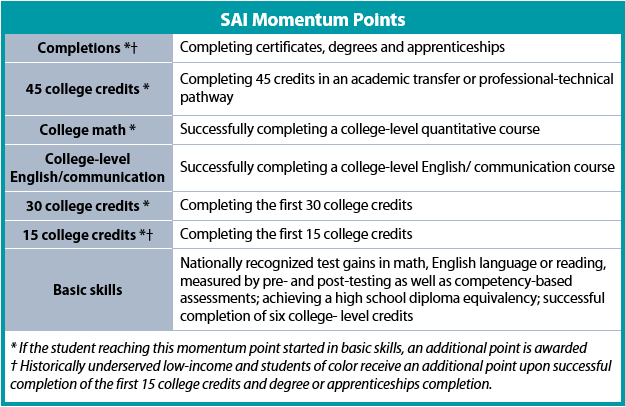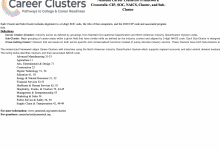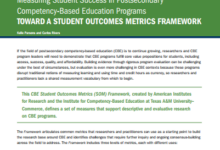Washington’s Student Achievement Initiative (SAI) was launched in 2007 by the Washington State Board for Community and Technical Colleges (SBCTC) as part of a larger, statewide effort to improve success for postsecondary learners in Washington’s 34 community and technical colleges. The initiative utilizes a point-based system to measure student progress and achievement and allocates state funds to institutions according to their performance. The initiative has undergone slight modifications over the past decade, but the objective remains the same: to encourage institutions of higher education to prioritize student success over enrollment.
Design of the SAI Formula

The SAI formula serves two functions. One is to hold institutions accountable for student success and reward those that help learners progress towards a postsecondary credential. The second is to provide actionable data to institution leaders and equip them to intervene when learners miss critical milestones.
As such, the point system is designed to value student progression, recognizing learners who transition from basic skills education to credit-bearing coursework and those who meet critical academic milestones. The point system was conceived based on extensive research and faculty input, and the design has been modified slightly over the past decade, drawing on the latest research and best practices.
Another feature of the SAI formula is a focus on historically underserved populations. The point system is weighted to ensure institutions are not penalized for serving at-risk learners, who may be less likely to complete. This is a lesson learned from other states that incentivized credential attainment rather than progression, only to find institutions neglecting the learners most in need of support. The way SAI works, institutions receive additional points for certain focus populations that transition to college-level courses and accrue sufficient credit. To date, the focus populations included in the formula are: basic skills students, historically underserved low-income students and historically underserved students of color.
So how does the SAI point architecture translate to institution-level funding decisions? In Washington State, 5 percent of state funding for community and technical colleges is distributed according to the SAI formula. Institutions do not compete directly for funds; rather, they have to demonstrate progress compared to a benchmark year. Funds are distributed based on an institution’s performance in three categories:

Policy in Action
SAI was put into motion more than a decade ago, and the formula has undergone some substantial changes in that time. In the 2013-14 academic year, modifications were made to the point system to elevate transitions for basic skills students and prioritize progression towards a postsecondary credential. Updates were made again in the 2017-18 academic year to adopt recommendations from the SAI advisory committee. The committee encouraged SBCTC to focus on degree attainment and progression specifically for historically underserved students.
Implementation of the SAI formula was slowed due to the downturn of the national economy in 2008. While the formula was initially designed to supplement each institution’s base allocation, the Washington State legislature cut state funding to higher education, forcing SBCTC to use the formula to redistribute base funding. As a result, staff and faculty in the community technical colleges were frustrated that the formula functioned more as a penalty rather than an incentive, according to a three-year evaluation by the Community College Research Center (CCRC). However, SBCTC was able to secure support from philanthropic partners, and the state legislature eventually put $10.5 million toward the initiative in the 2013-15 budget.
A separate evaluation by the American Education Research Association (AERA) found that community colleges issued more short-term certificates after the reform was put in place, though the number of associate degrees issued remained flat during the study period.
Related Links
- Website: Student Achievement Initiative
- Webinar Slides: SAI 3.0 Criteria (2018)
- SAI Criteria and Documentation (2018)
- SAI Data Dictionary (2018)
- SAI Dashboards
- AERA Report: Evaluating the Impacts of “New” Performance Funding in Higher Education (2015)
- CCRC Report: Metrics, Dollars, and Systems Change: Learning From Washington State’s Student Achievement Initiative to Design Effective Postsecondary Performance Funding Policies (2013)
- CCRC Report: Washington State Student Achievement Initiative Policy Study: Final Report (2012)





